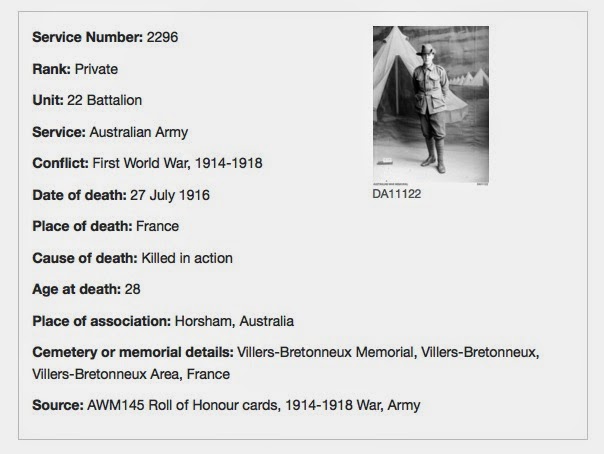Donald William McTAVISH was born in 1888 in Horsham, Victoria, Australia, the third child for Donald McTAVISH and Anne CHANDLER.
At the age of 27 years, Donald - a farmer - enlisted in the AIF on 24th July 1915 to the 22nd Battalion 4th Reinforcement with service number 2296. He enlisted the same time as his cousin - Harold McTAVISH who was given the service number 2295.
 |
| 22nd Battalion in France |
By the 26th July 1916 they were on march from Lealvillers to Albert.... at 5.30pm the Battalion moved off passing thru Albert to Sausage Valley where the Battalion was issued with picks, shovels, two mills bombs each and two sandbags. At 11pm Battalion moved off to relieve 6th Battalion AIF in POZIERES.
at 4.30am on 27th July 1916 they were occupying trenches in Pozieres. Enemy shelling commenced at
6.30am in response to the Battalion artillery fire. Shelling was intense. On this day,
in the 22nd Battalion, 21 KIA, 19 MIA, 129 wounded.

Battle of Pozieres ~ one year and three days from time of enlistment.
Army records state that Donald William McTAVISH died between 27th July and 4th August. (4th Aug
was when his cousin was severely injured) But his death was always remembered as being on 27th July each year.
 |
| View across the Pozières plateau in August 1916 |
 |
| 22nd Battalion Cross Erected at Pozieres |
Donald William McTavish is remembered with honour at
Villers-Bretonneux Memorial
No known grave
Villers-Bretonneux Memorial
No known grave
Donald William McTavish is remembered at the
Australian War Memorial.
Australian National Memorial, Villers-Bretonneux, France
Villers-Bretonneux is a village about 15 km east of Amiens. The Memorial stands on the high ground ('Hill 104') behind the Villers-Bretonneux Military Cemetery, Fouilloy, which is about 2 km north of Villers-Bretonneux on the east side of the road to Fouilloy.
The Australian National Memorial, Villers-Bretonneux is approached through the Military Cemetery, at the end of which is an open grass lawn which leads into a three-sided court. The two pavilions on the left and right are linked by the north and south walls to the back (east) wall, from which rises the focal point of the Memorial, a 105 foot tall tower, of fine ashlar. A staircase leads to an observation platform, 64 feet above the ground, from which further staircases lead to an observation room. This room contains a circular stone tablet with bronze pointers indicating the Somme villages whose names have become synonymous with battles of the Great War; other battle fields in France and Belgium in which Australians fought; and far beyond, Gallipoli and Canberra.
On the three walls, which are faced with Portland stone, are the names of 10,885 Australians who were killed in France and who have no known grave. The 'blocking course' above them bears the names of the Australian Battle Honours.
After the war an appeal in Australia raised £22,700, of which £12,500 came from Victorian school children, with the request that the majority of the funds be used to build a new school in Villers-Bretonneux. The boys' school opened in May 1927, and contains an inscription stating that the school was the gift of Victorian schoolchildren, twelve hundred of whose fathers are buried in the Villers-Bretonneux cemetery, with the names of many more recorded on the Memorial. Villers-Bretonneux is now twinned with Robinvale, Victoria, which has in its main square a memorial to the links between the two towns.
Donald William McTavish's name will be projected onto the exterior of the Hall of Memory at the AWM in Canberra on:
- Tue 19 August, 2014 at 5:17 am
- Thu 2 October, 2014 at 11:15 pm
- Tue 25 November, 2014 at 4:30 am
- Mon 19 January, 2015 at 8:38 pm
- Thu 12 March, 2015 at 6:03 am
- Sun 26 April, 2015 at 10:01 pm
- Sun 7 June, 2015 at 12:17 am
- Tue 14 July, 2015 at 6:54 am
These dates and times are estimates. The
actual time of projection could change as a result of weather and other
factors, so it is advisable to check closer to the date. In the rare
event of a temporary loss of electrical power, the names scheduled for
display in that period will not appear until the next time listed.
With grateful thanks to:
The Australian War Memorial
The Australian National Archives
Australians on the Western Front
for further information and the use of their images off their sites.
LEST WE FORGET
.
















Lest we forget.
ReplyDelete